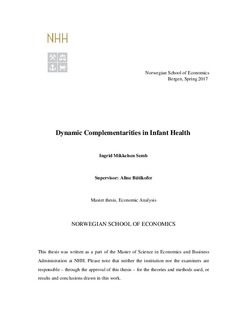Dynamic complementarities in infant health
Master thesis
Permanent lenke
http://hdl.handle.net/11250/2454007Utgivelsesdato
2017Metadata
Vis full innførselSamlinger
- Master Thesis [4372]
Sammendrag
A large literature documents that early-life shocks may substantially affect health and
labor market outcomes. However, we do not know much about how different shocks
interact. In theoretical work, the idea of dynamic complementarities has been put
forward, implying that the effect of a positive shock is larger for individuals with a
higher baseline level of skills. With dynamic complementarities, negative shocks decrease
the returns to subsequent investments for affected children. In this setting, universal
interventions may in reality serve to strengthen initial differences. The policy
relevance of understanding whether dynamic complementarities exist can therefore
hardly be underestimated, but no clear answer has yet emerged from the literature. I
utilize two arguably exogenous sources of variation in infant health in Norway between
1935 and 1945 to shed light on this question. The first shock is fetal exposure
to seasonal influenza, which has been shown to negatively affect long-term health
and labor market outcomes. The second shock is access to well-child visits, which
is known to improve similar outcomes. Specifically, I ask whether fetal exposure to
influenza reduces the long-term returns to mother and child health care centers. This
is a particularly relevant question for policy-making because seasonal influenza is a
frequent shock, yet easily preventable by means of vaccination. If influenza lowers
the returns to a universal intervention like mother and child health care centers, inequality
of opportunity could therefore be reduced by increasing vaccination rates
among pregnant women. Using detailed individual-level registry data, I find little
evidence of influenza affecting the educational or labor market returns to well-child
visits. This lack of significant interaction effects could however be driven by the
two shocks not affecting the outcomes of interest in my sample. Further research is
therefore necessary in order to understand whether returns to mother and child health
care centers are lower for infants who were exposed to maternal influenza.
